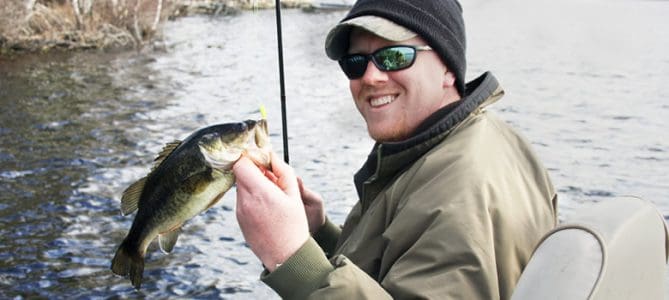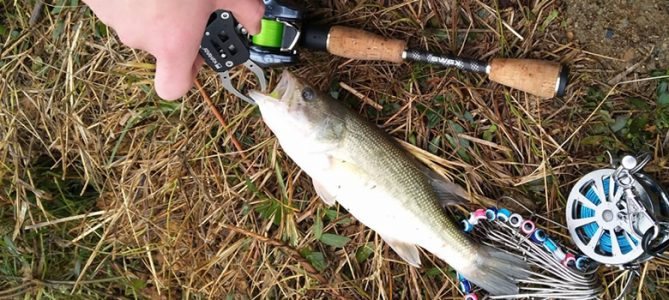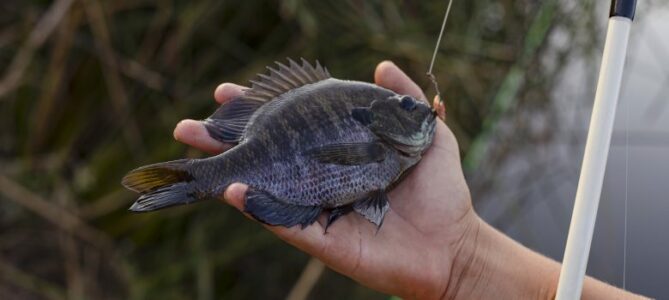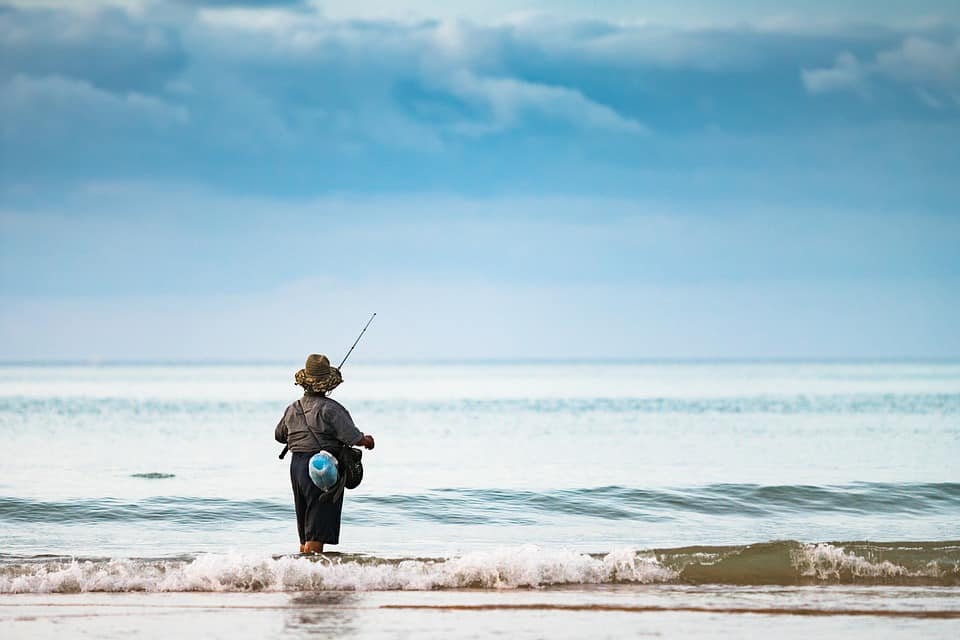If you buy via a link on this page, we may receive a commission, at no extra cost to you.Learn more
Bass and trout are two of the most popular species to fish for. Both fish are mostly found in freshwater and can tend to be around the same size as each other. While it’s possible to catch both types of fish with similar techniques, it’s much more effective to specialize for each species.
Knowing how to target each different species of fish will go a long way towards improving your skills as an angler. Fishing for both bass and trout can be pleasurable on its own, but it’s always more fun when you’re catching a lot of fish. To find out the best techniques for targeting both species of fish, we’ve provided this in-depth guide. So, what’s the difference between bass fishing and trout fishing? We cover that and everything else you need to know about bass and trout.
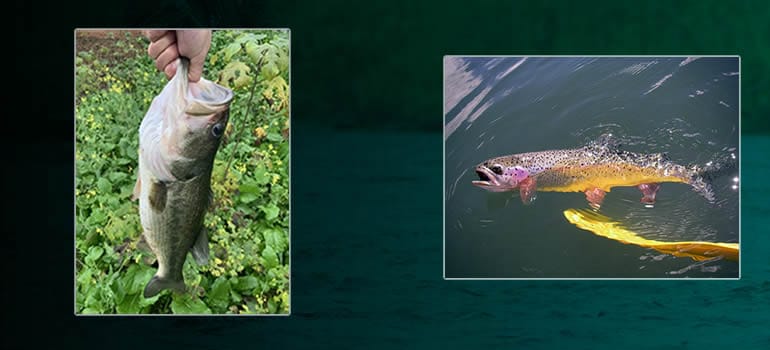
If you want to be prepared for any type of bass or trout fishing situation you find yourself in, you’ve come to the right place. Trout and bass have unique appetites and behaviors and understanding how the two fish species differ is imperative to your future as a fisherman. After reading this article you’ll be an expert on both bass fishing and trout fishing.
Here’s What to Know About Bass Fishing
Many people prefer bass fishing for a variety of reasons. Some of these reasons include:
- Bass is easier to find. Depending on where you live, you may not have many trout near you.
- Bass can grow larger than some trout, so if you enjoy catching big fish, bass fishing may be your choice.
- Bass has fewer bones than trout, making them easier to filet and eat.
Freshwater bass come in two distinct species of black bass: largemouth, and smallmouth. Both species tend to fight harder than trout, but they also tend to be easier to catch. Below are the key characteristics to know about smallmouth bass, and largemouth bass. This includes when they spawn, and what lures and techniques to use for catching both.
Largemouth Bass
Largemouth bass can be caught all year long, you just need to know what depth to target depending on the time of day, and time of the season. At dusk, largemouth bass moves towards the shoreline, making them an ideal target for night fishing.
Key characteristics of largemouth bass:
- There is a break in the dorsal fin, making it look like two separate fins on top.
- The jawline on the largemouth is longer and extends past the eye.
- Largemouth bass is greener in color and features horizontal stripes and spots.
- In general, largemouth bass prefers warmer water.
- The world record for largemouth bass weighed 22 pounds, 4 ounces, and was caught in Georgia on Montgomery Lake.
Where to Find Largemouth Bass
Largemouth bass fishing is best down south, where the lakes are warmer. When you’re fishing on a warmer weather lake, look for largemouth bass near the cover. The cover includes logs, rocks, brush, and weed beds. You won’t be sight fishing for largemouth bass. Toss your lure into the brush and you should have a good chance of attracting the attention of largemouth bass.
If you’re on a river and targeting largemouth, look for the slowest-moving waters. The big lazy largemouth doesn’t like faster currents. Look for brush, shelter, and cover in calm patches of water and if there are largemouth, that’s where they’ll be.
In the summer, largemouth bass hangs out in shallow waters, such as creeks and bays. No matter what time of the year, largemouth bass will be in the densely covered areas of the water.
Smallmouth Bass
Smallmouth bass fishing is most productive during the spawning season, which is usually in late May and early June. Smallmouth bass doesn’t grow quite as large as largemouth, but they can still top 5 pounds and 20 inches with ease and frequency.
Key characteristics of smallmouth bass:
- The top fin on a smallmouth, known as the dorsal fin, is one continuous piece with no break.
- With a smaller mouth, the upper jaw of a smallmouth does not extend past its eye.
- Smallmouth bass has vertical stripes and a browner body.
- In general, smallmouth bass prefers colder water.
- The world record for smallmouth bass weighed 11 pounds, 15 ounces, and was caught on the Kentucky-Tennessee border.
Where to Find Smallmouth Bass
A big difference between smallmouth and largemouth bass in rivers is that you can find the smallies in fast currents. Both species enjoy going near cover, but the difference in smallmouth bass is that they typically hunt on the edges of cover, rather than going straight in. So, when targeting smallmouth bass, fish near the edges around large rocks, stumps, and weed beds.
Smallmouth bass is found in open waters during the summer, while largemouth like to stick only to the crowed covered spots on a lake. You can target smallmouth bass in shallow waters close to shore when they are first spawning in the spring. Once the weather and water get warmer, the smallmouth goes deeper. When the season turns to fall, smallmouth will venture back towards the shallow water near the shore.
How to Fish for Bass
The biggest key to knowing when fishing for bass is where to target them. Once you’ve found a good spot, you can use a variety of different techniques and have similar amounts of success fishing for either largemouth or smallmouth bass.
Crankbaits work wonders on smallmouth bass, and you can read more about crankbait fishing here. Use whatever lures and gear you’re most comfortable with. If you’re comfortable with a baitcasting rig, crankbaits are a tried and true way to slay bass. If you prefer spinning gear, soft plastics, worms, and spinnerbaits can all be effective.
With largemouth bass preferring the densely crowded areas of the water, flipping, and pitching are one of the most successful techniques to use. This involves finesse fishing that allows you to softly land your bait into small areas with shorter casts. But that’s not the only technique to use for largemouth bass. Having a largemouth hit a topwater plug is a thrilling experience that every angler must experience in their lives. Shallower crankbaits will work wonders on largemouth bass, as well as vibrating jigs and spinnerbaits.
Here’s What to Know About Trout Fishing
While there are many more species of trout than bass, trout can be effectively broken down into two types. The most popular are trout found in rivers and streams such as brook trout, brown trout, rainbow trout, and cutthroat trout. The other type of trout that you can catch only in lakes is lake trout, which are an entirely different animal from the others.
Lake Trout
Lakers can grow to be extremely large, dwarfing enough the biggest bass you can catch. You can catch a lake trout on a lure by accident when fishing for northern pike, but most lake trout fishing involves finding the deepest parts of a lake and dropping large, heavy jigs, and trolling the area.
Lake Trout can grow to be massive in size, the world record for lake trout is 72 pounds. These behemoths are incredibly difficult to pull up when fishing 100 feet deep into a lake. In order to bring up a huge lake trout, you’ll want a rod and line with a test pound high enough to not break. You will also need to use incredible patience, as the fight with a lake trout this size could go on for nearly an hour.
The best setup for lake trout jigging is as big of a jig as you can find, with a large hook. What has worked best for me is taking meat from another fish, such as a northern pike, and putting that on the hook. If you can get a piece of fish that still has the skin attached to it, that will make it much more difficult to fall off the hook on a bite or while jigging.
You’ll also want a large weight or two spaced a foot apart towards the end of the line to get the rig to float down to the bottom. Deepwater lake trout fishing is best at dusk when the sun has fully set. Using a GPS fish finder, try to locate a pack of lake trout and drop your jig down to the desired length. Now, start trolling around the area. You can let outline to have your lure dive down and periodically jig back and forth to get the trout’s attention.
If you aren’t having success with this technique, reel your line up to make sure the bait is still attached to the hook. If you’re fishing with other people on the boat, you also want to be aware of not tangling up your lines if you’re trolling in a circle. Sometimes you may think you have a bite, but it’s actually your line crossing your friends’ line, leading to a tangle.
Rainbow and Steelhead Trout
Both rainbow trout and steelhead trout belong to the salmon family. The difference between the two is that steelhead trout are rainbows that live most of their life in saltwater, before returning to rivers to breed. Regular rainbow trout as most people know them spend their entire lives in freshwater. These rainbow trout will not grow to nearly the size of steelhead trout.
Rainbows can range in size, but most rainbows you’ll catch will be under 20” long. If you find wild waters where not many people fish, however, you can find rainbows topping 20” with regularity. Rainbow trout are distinguished by the red and blue rainbow-like coloring on their bodies that makes them unmistakable. Steelheads stay more silver in color and grow larger while living in larger bodies of water.
Brown Trout, Brook Trout, and Cutthroat Trout
Cutthroat trout are native to the United States and their range extends from the east coast to the Rocky Mountains. Cutthroats are mostly brown or gray in color, with black markings spotting their back. When rainbow and cutthroats breed with each other, the result is a “cutbow” trout. Cutbows share the same black spots on the trout’s back but feature the reddish color of salmon and rainbow trout on their bottom half.
Brown trout are my favorite-looking trout to catch. Their bodies are mostly brown throughout, but the way to identify a brown trout is by the black markings across their body, which are surrounded by a beautiful red hue.
Brook trout have similar black markings surrounded by a red hue, but also feature wavy, often green and yellow markings that distinguish them from brown trout. A less often seen variation of brook trout is the tiger trout, which came about from browns and brookies breeding with each other. These tiger trout feature the wavy, tiger-looking stripes of the brook trout, but without the red and black spots seen on brooks and browns.
There are other variations of trout but are seen far less frequently than those mentioned above. One last species of trout to highlight is the highly sought-after golden trout. The golden trout is easily distinguished by a bright yellow or “gold” coloring. The state fish of California, a golden trout has a red stripe running through its body and a variety of black spots. Golden trout prefer water temperatures between 58 and 62 degrees Fahrenheit and are found in higher elevations between 6,000 and 10,000 feet above sea level.
How to Fish for Trout
Fishing for trout on a stream or river is all about stealth. Spook one trout and you can spook up to 10 or more as the one spooked fish rapidly swims past other fishing holes and puts new trout on high alert.
One of the most common ways to fish for trout is with a fly. Fly fishing for trout is light years different than bait fishing for bass. Fly fishing involves a completely different setup, with a fly rod, fly reel, and fly line. Fly fishing also is typically done while wading into the water, rather than fishing from a boat. You can also fly fish from the shore, but fly fishing is all about presentation and targeting the right area of the water. In order to reach certain areas on the water, you sometimes have no choice but to wade in.
The key to trout fishing is to keep your distance and both stay out of sight and scent. Once the trout see you or smell you, it’s game over. Trout fishing also involves sight fishing. This is when you slowly approach clear water and see the fish before throwing your line in. When sight fishing, throw your line beyond the fish and let the bait naturally drift past its face.
Key Differences Between Trout Fishing and Bass Fishing
Bass Fight Harder than Trout
- If you enjoy the thrill of a hard strike, and a long fight, bass fishing provides both more than trout.
Trout are Pickier than Bass
- While bass fights harder, trout are harder to catch. You usually have one chance to catch a trout. If you miss it, the trout gets spooked and swims away. Fishing for trout is generally more challenging than fishing for bass.
Trout Taste Better than Bass
- This isn’t a blanket true statement, because some may prefer the taste of bass to trout. Sea bass, in particular, is one of the best fish you can eat. But when discussing freshwater fish, most species of trout are preferred to bass when it comes to eating.
Trout has more Bones than Bass
- While trout may taste better, the bass is easier to filet with fewer bones to pick out. If you are learning how to filet a fish, start with bass to get the hang of it. Once you get good at filleting, try a trout and see for yourself which fish tastes better.
Trout Fishing is More About Technique
- Especially if you’re fly fishing, catching trout is all about stealth, and bait placement. When fishing for bass, both largemouth and smallmouth will often hit whatever lure is in front of their face. Trout, meanwhile, can completely ignore bait swimming by them. With that said, both trout and bass can be caught on topwater lures.
Trout Require a Lighter Hook Set than Bass
- Aggressive bass will slam your hook and take your bait, giving you an opportunity to set the hook hard into its mouth. With that said, you still must wait until you feel the bass fully take your lure before setting the hook. This is because bass opens their mouths and inhale water to take your lure. If you set the hook too soon the bass won’t have an opportunity to bite down.
- Trout, on the other hand, tend to nibble at your bait with their smaller mouths. If you set the hook too hard, you can rip your fly right out of the trout’s mouth.
Bottom Line on Bass vs. Trout Fishing
Trout are typically harder to catch and tastes better than bass. But bass is more fun to catch since they will hit most lures and provide more fun by jumping and fighting when reeling them in. Both species of fish have their pros and cons, the key is knowing what techniques to use to target bass and trout. Once you know where to look for these fish, you’ll have tons of fun catching both!

